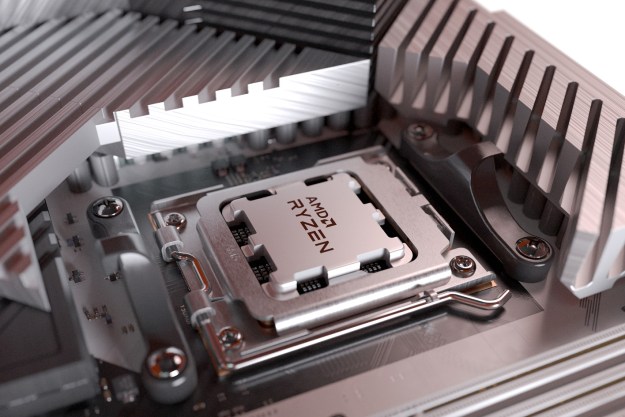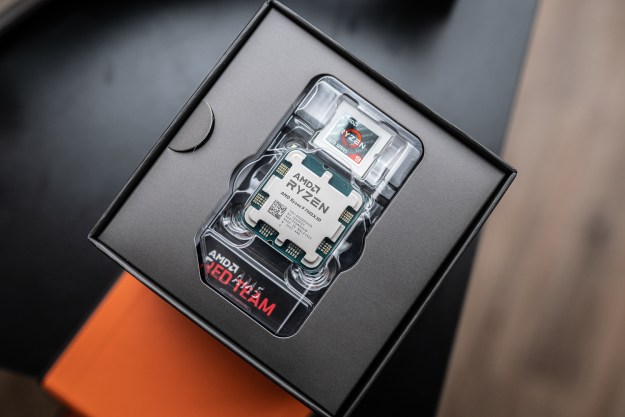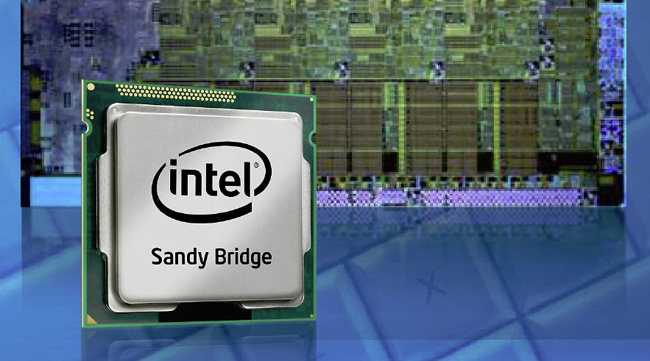
I’m sure you’ve heard the term Sandy Bridge thrown around – the articles and reviews on Intel’s second-generation Core i7 technology have more than proliferated by now. The consensus is that this “tock” in Intel’s “tick-tock” strategy is fresh, powerful, and a game changer. And even as good as Sandy Bridge is, it’s being positioned as Intel’s mainstream replacement platform, which actually makes for some interesting questions like, “If Intel’s keeping the X58 platform around as an enthusiast solution, how does Sandy Bridge stack up, and what, if any, advantages are there to it?”
With a new chipset, new capabilities, new price points, and new power efficiencies, there’s a lot to consider when evaluating Sandy Bridge, but in my experience, it’s all in favor of Intel’s latest creation.
What is Sandy Bridge?
Sandy Bridge is the code word for Intel’s latest 32nm mainstream processors. They come in various flavors, from dual-core Pentium and Core i3 processors, to quad-core Core i5 and Core i7 variants. They all feature the latest iteration of Intel’s HD Graphics – which turns out to be a fairly powerful update for certain flavors of these new processors. Each of these new models feature Intel Quick Sync Video, a dedicated video transcoder that, when used in conjunction with the integrated graphics core, delivers a quantum leap in video transcoding power that even a discrete GPU cannot touch in terms of speed.
Sandy Bridge requires a new socket and a new chipset, however, so those of you looking to upgrade from your existing configuration will need at the very minimum a new motherboard, and if you’re not using the latest DDR3 memory, you’ll find yourself forking over even more money. What you get in return is a very well-outfitted platform with smart configuration choices and most importantly, the bandwidth to support these new features. Intel has added SATA 6G to their chipset, replacing the need for finicky and often under-performing third-party controllers. Also, while not native to the platform, you’ll find almost all Sandy Bridge motherboards featuring USB 3.0 – a welcome endorsement of this high speed update to a venerable standard. The best part is that unlike Intel’s previous mainstream platform, they’ve made sure to provide enough bandwidth to each of these components to prevent data bottlenecks.
Performance for every budget
One of the cool things about Sandy Bridge is how well the platform scales up and down the price and performance stack. One can find Sandy Bridge motherboards south of $100, and enthusiasts can find three-way GPU, hardcore overclocking motherboards for over $300. Speaking of overclocking – how does 5GHz sound? At Maingear we’re hitting over 5GHz on select chips, and it’s pretty exciting to see this kind of performance out of a $300 processor. A word to overclockers – you’ll need to make sure you’re buying special “K” SKUs – currently the 2500K and the 2600K, in order to get the unlocked features necessary to facilitate overclocking.
Sandy Bridge performance breakdown
To get a good picture of where Sandy Bridge would fit – I tested similarly priced parts from Intel and AMD. I wanted to see how the Intel Core i7 2600K performed vs the Intel Core i7 950 – its closest rival in terms of price. I also wanted to see how it performed against AMD’s six-core flagship, the Phenom II X6 1090T. Moving down to the low end, I knew that AMD’s triple-core offerings were going to be cheaper than the lowest-end Sandy Bridge parts, but at what point is “a few bucks more” worth it for a notable increase in performance?
The results, I found, were impressive.
In Cinebench, a program used to test single- and multi-core rendering capabilities, I found that the 2600K came out way ahead of the Core i7 950 – 6.9 vs 5.52, respectively. And the AMD Phenom II X6 was only able to pull in a 5.7 – and this is one of the few tests where the six-core monolith should shine. The 2500K, with its lack of HyperThreading and 2MB less of L3 cache, came in slightly behind the Core i7 950, but nothing noticeable. Not bad for a CPU that costs two thirds the price. When I ran single-threaded benchmarks, however, Turbo Boost and pure IPC power showed that every Sandy Bridge chip I tested was faster than both the Core i7 950 and the AMD Phenom II X6.
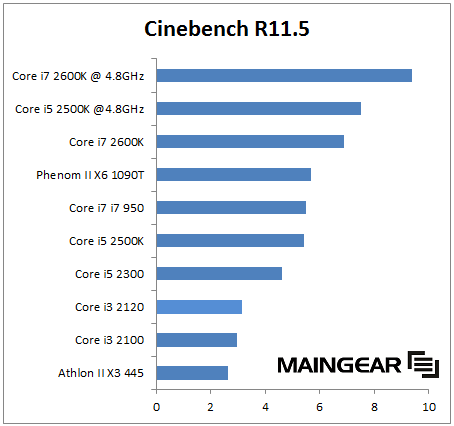
Moving on to video encoding using the x264 HD benchmark (Pass 2), the Core i5 2500K slightly trailed the Core i7 950 and AMD Phenom II X6, which were tied, but the Core i7 2600K outpaced them all by almost 20 percent.
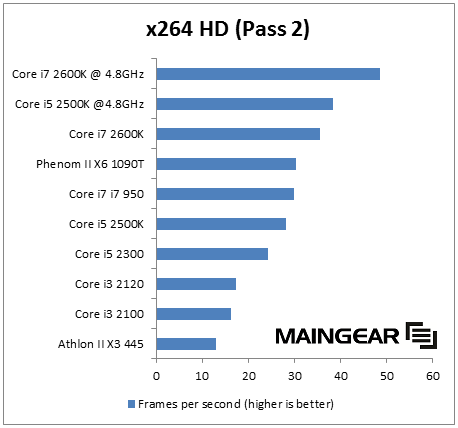
Integrated graphics performance was a mixed bag. You only get the faster GT2 performance (12 EUs) with more expensive K-SKU desktop parts, or Sandy Bridge mobile CPUs found in laptops – and that’s where the real story is. With Sandy Bridge GT2 graphics, you can play many mainstream titles like Dirt 2 at 720p and 25 frames per second. Sandy Bridge GT2 graphics were 50 to 100 percent faster than AMD’s 890GX chipset, long held to be the standard in integrated performance.

Finally, to get more of a whole-platform picture of performance, I ran PC Mark Vantage to test a variety of real-word activities and gaming. I was amazed to see every Sandy Bridge quad-core part beating the Phenom II X4 1090T and Core i7 950; even the entry-level Core i5 2300 was faster. Even more impressive was the fact that the dual-core Core i3 2120 tied the more expensive (and power hungry) Phenom II X6 1090T.

If you thought these numbers were impressive, the power consumption numbers are even better. Under load during Cinebench testing, the Sandy Bridge platform as a whole measured 113 watts from the wall, while the Core i7 950 platform I was testing measured 215. That’s amazing. And it wasn’t just power – heat and noise were night and day different. With stock coolers all around, you could hear the AMD Phenom II X6 and Intel Core i7 950 spin up during these tests, and you could feel the heat coming off them. With a cooler half the size of these other processors, Sandy Bridge hardly spun up, and most of the time felt room-temperature – an impressive feat to say the least.

What this all means
What this means for you is that while Intel meant to replace their mainstream platform, the P55, they in fact killed the X58 platform. With the exception of creative professionals willing to pay the price premium for an Intel six-core processor, available only on the X58 platform, Sandy Bridge puts the nail in the X58 coffin. X58 motherboards cost more, the processors cost more, you have to buy one extra stick of memory, and it consumes way more power than Sandy Bridge. For the enthusiast, it doesn’t even overclock as well.

Unless you make money with your system doing 3D renders, video editing, and are willing to fork over a lot more money for Intel six-core chips, get a Sandy Bridge processor. It’s a game changer, it’s lighter on your wallet and your electricity bill, and outperforms anything in its price class by an incredible margin.
Guest contributor Chris Morley represents the brains behind the hardware at Maingear, where he and his team cook up custom desktops, notebooks and workstations that will melt your face off. Having pushed Sandy Bridge through its paces (and all the way up to a neck-snapping 5GHz) for Maingear, Morley graciously left us with his own impressions – and the benchmarks to back them up.
Editors' Recommendations
- The only Intel CPU you should buy is over a year old
- Intel just launched the ‘world’s fastest’ CPU
- Apple’s M3 Max appears to keep up with Intel’s top desktop CPU
- It’s the end of an era for Intel
- Intel Core i5 vs. i7: Which CPU is right for you in 2023?


